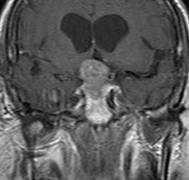A pituitary tumour is an abnormal growth of pituitary cells which occur due to genetic aberrations. The exact nature of which remains largely unknown and is likely to be different between subtypes of pituitary tumours and between individuals.
Pituitary tumours make up 10% of all the brain tumours and are found in up to 25% of individuals at autopsy. Clinically significant pituitary tumours occur in just over 1 in every 1000 individuals. They are commonly found in young or middle aged adults.
Almost all pituitary tumours are slow growing, and are typically benign. They are usually discovered either due to their hormone secreting effects, or by causing compression of surrounding normal pituitary (resulting in hormone loss) or important brain structures such as the visual pathways. Significant long term health consequences can occur due to the effects of pituitary tumours, making early diagnosis vital.
Treatment options will vary depending on the type of tumour (hormone secreting or non- hormone secreting), their size (micro- or macro-adenomas) and the person’s age and general health.

Types of Pituitary Tumours
1. Hormone secreting pituitary tumours.
- Prolactin-secreting tumours (Prolactinoma) :
Overproduction of prolactin by the pituitary tumour causes loss of the menstrual periods and breast milk production in women.
Infertility is common in both men and women.
- Growth Hormone (GH) -secreting tumours:
Excessive production of growth hormone causes enlargement of the hands, feet, lower jaw and brows, and can also lead to high blood pressure and diabetes. This condition is called acromegaly, or gigantism if it occurs before growth stops during the teenage years.
- ACTH-secreting tumours:
Overproduction of ACTH causes the adrenal glands to produce greater amounts of cortisol. This causes a disorder known as Cushing’s syndrome. This syndrome is characterised by a round face, weight gain, increased facial hair in women, and mental changes such as depression.
- Thyroid Stimulating Hormone (TSH) –secreting tumours:
A tumour that releases too much TSH causes hyperthyroidism. These tumours are extremely rare.
2. Non-hormone secreting pituitary tumours.
Symptoms include:
- Visual loss
When macro-adenomas grow larger, the tumour may compress an optic nerve or the optic chiasm. This can result in blurry vision, progressive loss of outer peripheral vision and/or changes in colour perception.
- Pituitary Failure (hypopituitarism)
Compression of the normal pituitary gland can cause loss of sex drive, inadequate body cortisol levels resulting in low blood pressure and fatigue, and hypothyroidism.
- The “Stalk Effect”
Compression of the pituitary stalk, the structure that connects the brain to the pituitary gland, can cause a mild elevation in the hormone prolactin. This can cause irregular menstrual periods.
- Headache
- Pituitary Apoplexy
Pituitary tumours can suddenly bleed internally, leading to an abrupt increase in size. In other cases, the tumour can outgrow its blood supply, leading to swelling of the dead tissue. Pituitary apoplexy is a surgical emergency.




